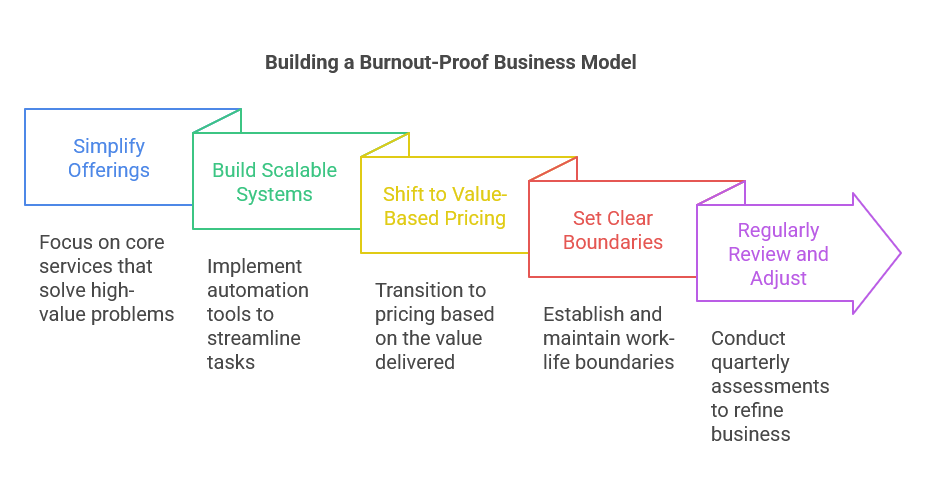How do I create a business model that doesn’t burn me out?

Sustainable Success: How to Build a Business Model That Fuels Growth Without Burnout
Your business should support your life, not drain it. Learn how to design a model that scales sustainably while preserving your energy.
Introduction
You started your business to achieve freedom and fulfillment—not to feel overwhelmed and exhausted. But as you juggle clients, marketing, and growth strategies, it’s easy to fall into a cycle of overwork and burnout.
So how do you break free? Imagine a business that grows alongside your ambitions without devouring your time and well-being—a business model designed to support you, not enslave you. This isn’t just possible—it’s essential for lasting success and happiness.
Let’s dive into proven strategies to create a sustainable business model that enhances your life while delivering value to your clients.
Why This Matters
"Building a sustainable business is like running a marathon—you need a steady, sustainable pace to reach the finish line, not a sprint that leaves you depleted halfway through."
Burnout often occurs when your business:
- Relies too heavily on your time and energy.
- Lacks systems and scalability.
- Doesn’t align with your values and priorities.
A sustainable business model ensures that:
- You have time to rest and recharge.
- Your income isn’t tied to trading hours for dollars.
- You can scale without working longer hours.
The Core Question
"How can you create a business model that supports growth and balance?"
The solution lies in three key principles:
- Scalability: Systems and offers that grow without increasing your workload.
- Alignment: A model that fits your goals, strengths, and values.
- Boundaries: Clear limits on your time and energy.
A Story of Transformation
Emma Rodriguez, a marketing consultant, was working over 60 hours a week just to keep her business afloat. She delivered great results for her clients but felt drained, with no time for herself or her family.
Here’s how Emma transformed her business:
- Streamlined Her Offers: She shifted from custom projects to a signature program that served multiple clients simultaneously.
- Built Systems: Emma automated her client onboarding and content scheduling, saving hours each week.
- Set Boundaries: She implemented a 4-day workweek and strictly adhered to office hours.
Within six months, Emma doubled her income while working fewer hours and feeling more energized.
5 Steps to Build a Burnout-Proof Business Model
1. Simplify Your Offerings
Focus on 1-2 core services or products that:
- Solve a specific, high-value problem.
- Can be delivered efficiently or scaled, such as group programs or digital courses.
Example: Instead of juggling multiple service packages, offer one comprehensive coaching program that delivers clear, measurable results.
Pro Tip: Use client feedback to refine your core offerings. Identify which services deliver the highest impact and satisfaction, then eliminate low-impact, time-consuming options.
2. Build Scalable Systems
Streamline repetitive tasks using automation tools:
- Client Onboarding: Use CRM software like Dubsado to automate contracts, forms, and welcome emails.
- Marketing: Schedule social media content with tools like Buffer or Hootsuite.
- Payments and Scheduling: Simplify payments and bookings with platforms like Stripe and Calendly.
Example: A digital agency implemented an automated proposal system, reducing time spent on admin tasks by 50%.
Quote: "Automation doesn’t replace personal touch—it amplifies your ability to deliver it consistently." — Tech Entrepreneur Lisa Chan
Infographic: Create a flowchart showing how automation reduces repetitive tasks, freeing up time for growth-oriented activities.
3. Shift to Value-Based Pricing
Charge based on the value you deliver, not the hours you work. High-ticket offers allow you to earn more with fewer clients.
Example: A digital marketer can charge $5,000 for a comprehensive strategy package instead of hourly rates, positioning their work as a high-value investment.
Pro Tip: Educate clients on ROI (return on investment). Use case studies to demonstrate how your services yield significant results, such as increased revenue or time savings.
4. Set Clear Boundaries
Protect your time and energy by:
- Defining work hours and sticking to them.
- Saying “no” to projects or clients that don’t align with your values.
- Delegating non-essential tasks.
Metaphor: Think of boundaries as the “guardrails” that keep your business on the road to sustainability.
Example: An entrepreneur declined last-minute projects outside her work hours. Instead of losing clients, she attracted respectful ones who valued her professionalism.
5. Regularly Review and Adjust
Schedule quarterly reviews to assess your business:
- Is it supporting your life, or draining it?
- What tasks can you automate, delegate, or eliminate?
Example: A small business owner might review their workflows and discover they can save 10 hours a month by outsourcing bookkeeping.
Pro Tip: Use key metrics like revenue per hour or client satisfaction scores to guide your adjustments.

Emotional Resonance
Your business should be a source of freedom and fulfillment—not stress and exhaustion. Imagine waking up excited to work, knowing that your business is growing without consuming all your time and energy. This balance is achievable with a sustainable model.
FAQs
1. How do I identify the right systems to automate?
Start by listing repetitive tasks that consume significant time, like invoicing or follow-ups. Next, research tools designed for small businesses, such as QuickBooks for accounting or Zapier for connecting apps and automating workflows. Begin with one task, test the system, and expand gradually.
2. What if my clients resist value-based pricing?
Focus on educating them about outcomes. For instance, highlight how a $5,000 marketing plan could drive $50,000 in revenue. Use testimonials, case studies, or industry benchmarks to validate your pricing model. Show them that your pricing reflects long-term value, not just upfront costs.
3. Can a small business owner implement scalability?
Absolutely! Begin by identifying a repeatable service, like a workshop or digital product. Document your process in detail to ensure consistent delivery. Tools like Trello or Asana can help streamline workflows. Remember, scalability doesn’t mean impersonal—it means structured growth.
4. How do I enforce boundaries with difficult clients?
Set expectations early. Clearly define communication hours and project timelines in your contracts. If boundaries are crossed, address them politely but firmly. For instance, "I understand this is urgent; however, I’ll be able to assist during my office hours tomorrow."
5. What are common mistakes to avoid when simplifying offerings?
Avoid spreading yourself too thin by trying to cater to every client type. Narrow your niche and focus on your ideal audience. Another mistake is undervaluing your core offering—invest in professional branding and marketing to position your service as premium.
🌟 Ready to design a sustainable business model that fuels your success and well-being? Let’s Build Your Blueprint 🚀
If something in this post hit home—this might be your moment to step into real clarity.
About the Author
Juan Carlos Arzola, CHPC, is a faith-driven visionary, proud Peruvian, and devoted single father of two incredible sons, living and thriving in Miami. As a Certified High-Performance Coach to the world’s most ambitious achievers—leaders pursuing transformative dreams such as Nobel Prizes, United Nations initiatives, and NASA-level innovations—Arzola is deeply committed to empowering others to lead lives of significance.
Arzola is the founder and CEO of Ask.me, a revolutionary platform designed to help professionals successfully transition into entrepreneurship. His own inspiring journey from employee to thriving entrepreneur reflects his unwavering belief in transformation through faith, purpose, and strategic leadership.
A best-selling author, Arzola wrote The Success Start: Proven Practices to Build a Life of Significance, a guide that has empowered countless readers to define and achieve their personal and professional goals. The book is available on Amazon and at the prestigious Harvard Book Store. As a co-author of The Big Question with broadcasting legend Larry King, he shares profound insights on life, leadership, and legacy. Learn more about his collaboration with Larry King here.
A sought-after speaker and podcast guest, Arzola has shared his expertise on renowned platforms including The Culture Matters Podcast, Grown Folks Talking Live, and The Dreamcast Podcast. With a focus on personal growth, high performance, and creating meaningful impact, he equips high achievers with actionable strategies and inspiring insights to refine their visions and achieve measurable success.
Arzola’s work blends practical wisdom with a deep sense of purpose, helping individuals unlock their full potential and leave lasting legacies. Learn more about his mission to transform lives and inspire change at Ask.me.


